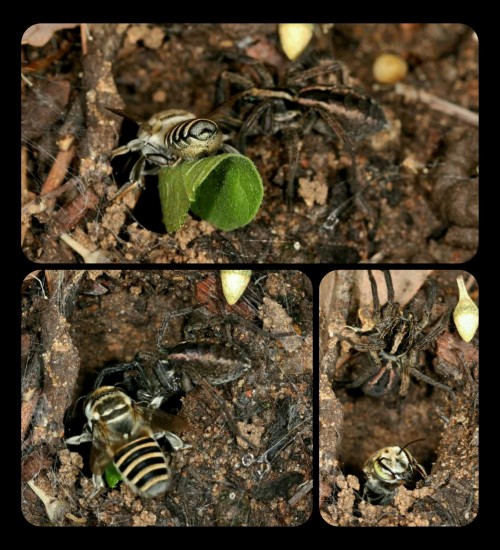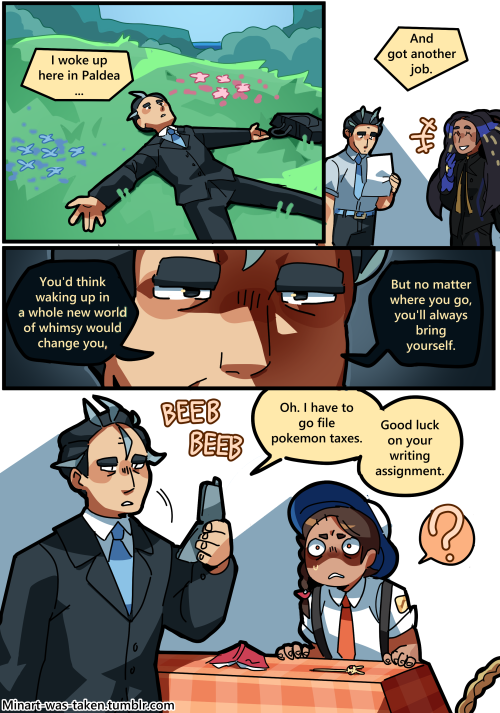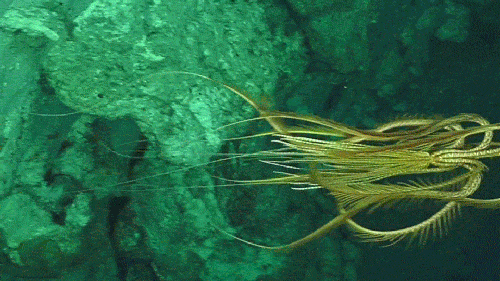
taiisdelusional
Wildly autistic | 20yo | pfp made using @reelrollsweat 's little guy maker
240 posts
Latest Posts by taiisdelusional
Chinese hourglass spider - 里氏盤腹蛛 - Cyclocosmia ricketti
The Chinese hourglass spider is a fascinating species of arachnid, a very rare one at that ! Between the years 2000 and 2016 ONLY six of these spiders have been spotted in China, that we know of.
@hispaatra, @zick-the-fairy more on the awesome seal :D


Description
Cyclocosmia ricketti has a very distinctive disk on its abdomen which resembles an ancient coin, a seal, or even a grinding disc. The male Cyclocosmia ricketti are about 20.5 millimetres in length while the females of the species tend to be slightly bigger at around 25.83 to 30.0 millimetres in length. The largest known specimens can exceed 30 millimetres. The disk located on its abdomen typically has a radius of around 16 millimetres.

Extract from 'Zhu, Zhang & Zhang, 2006 : Rare spiders of the genus Cyclocosmia (Arachnida: Araneae: Ctenizidae) from tropical and subtropical China.' Raffles Bulletin of Zoology, vol. 54, No. 1, p. 119-124
According to Zhao Li, Director and Senior Biological Engineer of the Insect Museum of West China in Chengdu, Sichuan, Cyclocosmia ricketti is a nocturnal animal.
Predation behaviour
Cyclocosmia ricketti, like many other trapdoor spiders, dig burrows which are closed off by hatches in the ground. They do this instead of making webs, as they are not good at spinning silk, to catch their prey. They line their burrows with silk threads and mud. They use their disk to plug the opening of the burrow. When a small insect would step on its disk, Cyclocosmia ricketti will then purportedly shrink its abdomen to allow its prey to fall further into its burrow to be devoured. The disk also makes it difficult for its prey to escape from its grasp.
Cyclocosmia ricketti doesn't always use this method to hunt, as when its confronted with a non-threatening insect, Cyclocosmia ricketti will get out of its burrow and then directly grab it to eat it. This spider can also use the coin-shaped disk on its abdomen to protect itself from enemies by blocking the entrance to its burrow with it, and using it as a shield, a phenomenon called 'phragmosis'.
Distribution
Cyclocosmia ricketti are found in the Chinese provinces of Fujian, Zhejiang, and Sichuan. They are primarily found living in caves. The farthest north they are known to have been found is Sichuan, this is notable as it was previously believed that Cyclocosmia ricketti were not able to survive in places where the temperature could drop below 13 degrees Celsius. Winters in the province of Sichuan are known to get even colder.
~~~~~~~~~~~~~~~~~~~~~~~~~~~~~~~~~~~~~~~~~
Image sources:
1.
https://za.pinterest.com/pin/604186106296940858/
2.
https://spidershoppe.com/products/cyclocosmia-ricketti-chinese-hourglass-trapdoor-sub-adults
3.
https://web.archive.org/web/20070811074158/http://rmbr.nus.edu.sg/rbz/biblio/54/54rbz119-124.pdf
~~~~~~~~~~~~~~~~~~~~~~~~~~~~~~~~~~~~~~~~~
Text references:
1.
Zhu, Zhang & Zhang, 2006 : Rare spiders of the genus Cyclocosmia (Arachnida: Araneae: Ctenizidae) from tropical and subtropical China. Raffles Bulletin of Zoology, vol. 54, No. 1, p. 119-124
https://web.archive.org/web/20070811074158/http://rmbr.nus.edu.sg/rbz/biblio/54/54rbz119-124.pdf
2.
https://en.wikipedia.org/wiki/Cyclocosmia_ricketti
Chinese hourglass spider - 里氏盤腹蛛 - Cyclocosmia ricketti
I forgot about this spider, but I LOVE it ! Its disc resembles an ancient coin or a seal. It has also been known to be confused with coins, but then appearing to be an arachnid.
@hispaatra, @zick-the-fairy you migth enjoy this one :D


I love this spider so much and it is a great inspiration for Dungeons and Dragons. Honestly, this spider is like it is from a fairy-tale or legend or something of the kind, it is magical (to me, at least) !
~~~~~~~~~~~~~~~~~~~~~~~~~~~~~~~~~~~~~~~~~
Image sources:
1.
https://za.pinterest.com/pin/604186106296940858/
2.
https://spidershoppe.com/products/cyclocosmia-ricketti-chinese-hourglass-trapdoor-sub-adults




The spinybacked orbweaver (Gasteracantha cancriformis) is a small species of spider found throughout South America, Central America, the Caribbean islands, and the southern part of North America. They can reside in a variety of habitats, but their main home is in woodlands and dense brush. They are mainly solitary, but will sometimes coexist with other colonial orbweaver spiders.
G. cancriformis is notable for its striking appearance. The head and thorax are small and , while the thorax is quite large and lined with six sharp spines. The coloration can vary throughout the spider's distribution; generally the head and thorax are black, while the abdomen can be white, black, orange, yellow, or even blue, and the spines can be red or black. Females tend to be between 5–9 mm (0.20–0.35 in) long, while males are much smaller at only 2 to 3 mm (0.1 in) long.
As an orbweaver, spinybacked orbweavers build large webs to catch their prey-- mainly small insects. Every evening, a female builds a new web and a male hangs by a single thread close by. The following morning, after consuming any insects she has caught, the female will either take down or eat the web so that a new one can be constructed the following evening. Depending on the size of her prey, she may either paralyze it with a mild venom or wrap it in webbing before consumption. There are few known predators of adult spinybacked orbweavers, due to their small size and prickly defense, but the eggs are known to be parasitized by wasps.
Spiny orbweavers only live for one year, and only mate once during that period. In the spring, males court females first by drumming on her web. If she does not become aggressive, he approaches and allows her to strap him down with silk. Following copulation, the female lays an egg sac with 100 to 260 eggs on the underside of a nearby leaf, and then dies. The male typically dies several days later; it is unknown whether he mates with other females during this period. Incubation takes 2-5 weeks, and the young mature quickly over the summer.
Conservation status: The IUCN has not evaluated the spinybacked orbweaver. However, the species has a large, widespread population, and is highly adaptable to living in urban areas, and so is generally considered stable.
Photos
Scott Nelson
Judy Gallagher
Kimberlie Sasan
OMG LOOK AT IT

MAG 142
@a-mag-a-day
my other MAG illustrations
No fucking way

Wake up, slut! New spider just dropped!
Hello everyone. It is my honor, and privilege to formally introduce you too: Hotwheels sisyphus.


This, lovely specimen, is named after the fact, it's genitalia resemble a Hotwheels track! The second bit, of its name, of course comes from the ancient legend of Sisyphus, a man who is forever cursed with rolling a boulder, up a hill. This divine punishment, reminded the researchers Bo Liu and Feng Zhang, who discovered it, of the circular copulatory tube, of the spider, which is basically like a spider uterus. It has only been found in China, and it was discovered this year! They are the only species in the genus Hotwheels. And they are a sort, of ground spider! Unfortunately, not much is known about them, since they are a relatively new species.

Green Tiger Moth (Chlorhoda thoracica), family Erebidae, Peru
photograph by Alejo Lopez
sorry but this is the funniest fucking thing to me
“The fascinating world of insects” by Free High-Quality Documentaries on youtube
Strange Bedfellows: these unprecedented photos show a leafcutter bee sharing its nest with a wolfspider

I stumbled across these photos while I was looking up information on leafcutter bees, and I just thought that this was too cool not to share. Captured by an amateur photographer named Laurence Sanders, the photos were taken in Queensland, Australia several years ago, and they quickly garnered the attention of both entomologists and arachnologists.

The leafcutter bee (Megachile macularis) can be seen fetching freshly-cut leaves, which she uses to line the inner walls of her nest. The wolfspider moves aside as the bee approaches, allowing her to enter the nest, and then she simply watches as the leaf is positioned along the inner wall.

Once the leaf is in position, they seem to inspect the nest together, sitting side-by-side in the entryway; the bee eventually flies off again to gather more leaves, while the wolfspider climbs back into the burrow.
The leafcutter bee seems completely at ease in the presence of the wolfspider, which is normally a voracious predator, and the wolfspider is equally unfazed by the fact that it shares its burrow with an enormous bee.
The photographer encountered this bizarre scene by accident, and he then captured a series of images over the course of about 2 days (these are just a few of the photos that were taken). During that 2-day period, the bee was seen entering the nest with pieces of foliage dozens of times, gradually constructing the walls and brood chambers of its nest, and the spider was clearly occupying the same burrow, but they did not exhibit any signs of aggression toward one another.
The photos have been examined by various entomologists and arachnologists, and those experts seem ubiquitously surprised by the behavior that the images depict. The curator of entomology at Victoria Museum, Dr. Ken Walker, noted that this may be the very first time that this behavior has ever been documented, while Dr. Robert Raven, an arachnid expert at the Queensland Museum, described it as a "bizarre" situation.
This arrangement is completely unheard of, and the images are a fascinating sight to behold.
Sources & More Info:
Brisbane Times: The Odd Couple: keen eye spies bee and spider bedfellows in 'world-first'
iNaturalist: Megachile macularis







Stabbed! A short comic
made for an anthology awhile ago


So I have this headcanon about Larry...

One of this year's Olympic long jump competitors from the country of Arachnistan.





well maybe if you looked at some jumping spiders wearing water droplets as hats you’d calm down




European garden spider (Araneus diadematus)/korsspindel. Huddinge in Stockholm, Södermanland, Sweden (August 18, 2013).








the transparent bugposting will continue until morale improves part 9/??
jumping spider edition
(all from photographs taken by me)












Spider plushies by plaything_co



How can someone have such a distain for spiders. I mean, look at this sweet little creature 😭🖤
If you think people used to willingly stare off into the distance before smartphones, my dad told me he had this psychology assignment when he was in college in the 80s which was basically
Go to a restaraunt by yourself and eat a meal without a newspaper or journal or anything else to keep you occupied and then write a report about it
Which tells me that this was a way for a professor to inflict psychological torture on their students and that people used to bring little things with them to keep them entertained. Shown by those old pictures of everyone in a trolley reading a newspaper with one hand.
Frankly I think that the human brain has been craving smart phone forever. Perhaps we use it too much at times but if this was 1985 we also wouldn’t be talking to people. We’d just be looking at newspaper or drawing stuff on notepad instead. And the old people would all be shaking their fists about how kids spend too much time looking at that damn TV because yes this discourse has been going on long before smart phone









Magnificent bolas spider, Ordgarius magnificus, Araneidae
Found in southeastern Australia
Photos 1-2 by doggy48, 3-4 by michaeldoe, 5-7 by nicklambert, 8 (for scale) by rhett_dodd, and 9 (egg sacs) by imcmaster
Turn based sex. Take as long as you need to think of a strategy.







Jumping spider, Paraphidippus fartilis, Salticidae
Found from Texas, through Mexico and Central America
Photos 1-4 (female) by djringer and 5-7 (male) by ag18
People who like mantises but aren't that into entomology are always "orchid mantises" this and "orchid mantises" that. Overrated. Can we talk about Toxodera integrifolia for a minute:



(Image links because as much as it pains me I've never seen one of these beauties irl: 1 2 3)
Like how are these things real. Girl what is that thorax shape. Why are you wearing eyeliner. And the colors? Absolutely fire. This is a 10/10 insect if you ask me.





?










Jumping spider, Phiale guttata, Salticidae
Found from Mexico down through Brazil
Photos 1-2 by jorgearrestre4, 3-5 by benoit_segerer, 6-7 by mason_s, 8 by b_louboutin, and 9-10 (for scale) by isaof
crinoids are so insane what's up with them


????? plant


??????? plant whos schmoovin



unanswered thoughts about where consciousness comes from, and the degrees with which consciousness exists, rooted in the perception of body and time

